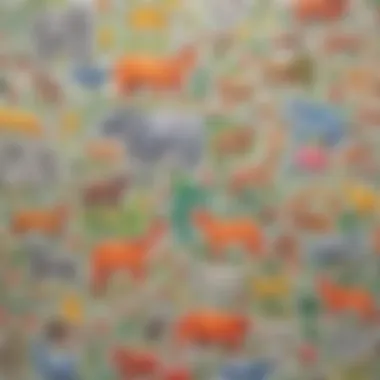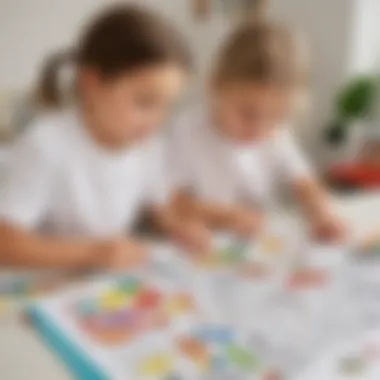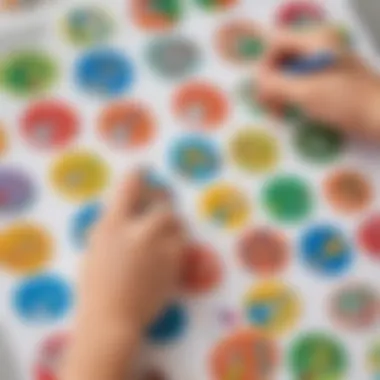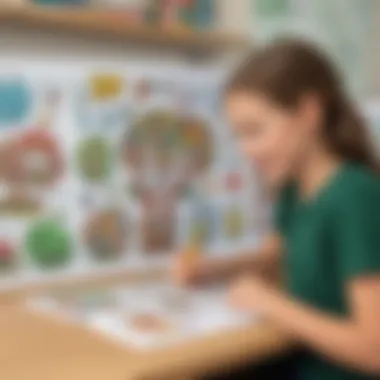The Evolving Landscape of Colouring Stickers: Educational Insights


Intro
The use of colouring stickers in children's education is an exciting topic that invites deep exploration. Their vibrant nature and engaging forms contribute to substantial cognitive and physical development in children, particularly those aged between 3 and 12. In this era of increasing reliance on technology, the integration of simple tools like colouring stickers holds unique value.
Colouring stickers serve not just as products of beauty. They inspire creativity, helpful in developing motor skills, and recognizing colors and shapes. The challenge today lies in understanding how these colorful resources enhance various learning domains.
As we delve deeper into this subject, we will highlight interactive learning games, emphasize the relevance of interdisciplinary educational topics, and provide tips that apply both in homes and classrooms. Each section aligns with the goal of enriching children's learning through creative expression.
Understanding Colouring Stickers
Understanding colouring stickers is crucial in discussing their applications and benefits within educational settings. These items serve not just as entertainment for children but also facilitate significant learning experiences. By exploring the definition, characteristics, and different types of colouring stickers, we can unearth how they contribute to children's development. This section offers insights tailored for parents, teachers, and caregivers, to help them enrich children's interactions with colouring stickers effectively.
Definition and Characteristics
Colouring stickers are adhesive products designed for artistic creation. They usually feature pre-printed outlines that children can fill with colours. This concept merges the traditional art of colouring with the accessibility of stickers, making it an engaging tool for creativity. Key characteristics of colouring stickers include:
- Convenience: They are easy for children to use. Simply peel, stick and colour.
- Variety: They can come in various themes and designs, catering to different interests.
- Reusability: Many stickers can be used multiple times in different contexts or settings.
In addition to these aspects, layering ingredients like brightness and themed characters maximizes their appeal.
Types of Colouring Stickers
Different types of colouring stickers serve distinct purposes. Their designed forms impact children's learning outcomes and creative engagements. Here are three main types:
Classic Colouring Stickers
Classic colouring stickers present familiar designs ready for colouring but lack interactive elements. The simplicity of these stickers often brings pure joy to very young children. Their popular nature lies in how they invite exploration of colours without distractions.
- Key Characteristics: They tend to feature predefined designs that allow specific colour applications.
- Benefit: They promote standard artistic sensibility and help build fine motor skills through the motions of placing colours within the lines.
- Unique Feature: Their straightforwardness makes them ideal for focused tasks, excellent for introductory experiences.
However, a drawback is that they may limit creativity if educational composition diverges too far from conventional outline patterns.
Interactive Colouring Stickers
Interactive colouring stickers revolutionize the experience through additional components. Some could contain digital features or augmented reality elements. These interactive stickers stimulate deeper engagement and learning processes consciously as they invite children to not just colour but also interact with stories and movements.
- Key Characteristics: Products utilize augmented features that may be activated through devices.
- Benefits: They increase reliance on digital literacy and problem-solving, essential in our modern world.
- Unique Feature: Many of these stickers come to life through technology, offering animations or challenges.
Although they present incredible possibilities, excessive reliance on technology can be seen as a downside by some. Monitoring screen time remains crucial.
Customisable Colouring Stickers
Customisable colouring stickers offer children the chance to design their products, thus cultivating strengths in creativity. Here, children can input personal touches by determining their configurations. Beyond just creative expressions, these stickers pave the way for learning through identity and self-representation.
- Key Characteristics: They can come in sets where children can choose various aspects, like colors or characters.
- Benefits: Empowerment through design. This stimulates their decision-making and encourages trademark creativity.
- Unique Feature: Since they can vary, they acknowledge and celebrate children’s unique ideas.
A limitation is increased complexity which might confuse younger users or dissuade them from participating with no guidance.
Understanding different types of colouring stickers equips educators and caretakers with knowledge to curate beneficial art experiences.
Historical Context
Understanding the historical context of colouring stickers is vital to appreciating their current educational benefits and practical applications. To comprehend their significance today, one must look back into their origins and evolution over time. This exploration helps reveal not just the development of a popular educational tool, but also the reasons behind its continuous integration into learning environments.
Origins of Colouring Stickers
Colouring stickers first emerged in the early twentieth century as an innovative tool aimed at young children. Initially, these stickers acted as decorative elements to enhance traditional educational materials. Educators recognized that adding these visual aids could increase engagement among students.


The concept was simplistic: bright and colorful images appealing to children were used to help them identify objects, colors, and even shapes. For instance, animals, vehicles, and characters were common illustrations. Over the decades, manufacturers began innovating their production methods. By the mid-1980s, stickers made of more durable materials became available, extending their usefulness far beyond their humble beginnings. This made them not only fun but also practical for varied educational purposes.
Today, brands such as Crayola and Melissa & Doug offer various products that reflect this shift in purpose. The introduction of removable and reusable stickers further distinguishes newer options from older, adhesive-based stickers. Their design simplicity has ultimately laid a crucial foundation for their educational potential.
Evolution of Design and Technology
As technology evolved, so did the design of colouring stickers. The 1990s saw a typical use of standard images and cheerful colors that aimed solely to entertain. However, contemporary designs incorporate advanced printing technologies that facilitate richer graphics and improved texture
Now, layers of design enable a more complex interaction. For example, teachers can now use interactive colouring stickers, which might embed educational prompts. Additionally, the shift toward environmentally friendly materials has gained popularity, with many brands producing stickers made from recycled or biodegradable substances. This has responded to growing concern about environmental impact, thus merging creativity with consciousness.
Benefits of this evolution are significant. Enhanced interactivity can not only capture a child's attention but lead to substantive learning experiences. This aspect merges creativity with cognitive engagement, providing parents and educators a versatile learning tool. Advances in design have clearly indicated the potential of colouring stickers as a viable educational instrument that captures interest while delivering educational content.
"Colouring stickers are a blend of art and education, showcasing how creativity has actively evolved alongside technological advancements."
The future, as indicated by these trends, appears poised for continued innovation. Understanding this historical context invites readers to appreciate the contemporary context wherein colouring stickers serve as more than mere play items—rather, they are sculpting permission for children's imaginations while enhancing essential developmental skills.
Educational Benefits of Colouring Stickers
Colouring stickers represent an impactful resource in the realm of education. Their multifaceted nature extends beyond mere entertainment, offering significant benefits for childhood development. A deep understanding of these advantages can empower parents, teachers, and caregivers to integrate colouring stickers into various learning environments. The upcoming sections will highlight these educational benefits, providing clear insights and practical implications stemming from their use.
Enhancing Fine Motor Skills
Fine motor skills are crucial for a child's development, as they involve smaller movements that require coordination of hands and fingers. Colouring stickers promote these skills through precision tasks like peeling, sticking, and aligning stickers with desired surfaces. Children must grip and manipulate these small items, which improves hand strength and dexterity over time. Moreover, positioning stickers within specific areas demands attention and motor control, enhancing visual-motor integration.
As these skills build, children prepare themselves for further activities such as writing, drawing, and other forms of creativity. Studies often show that engaging in such hands-on experiences can lead to measurable improvement in motor skills. In addition to developmental benefits, using colouring stickers when coupled with engaging scenarios or themes, makes the process enjoyable.
Encouraging Creativity and Imagination
Creativity holds immense value in early education, helping children express themselves while honing original ideas. Colouring stickers allow vast possibilities. By offering a blank canvass for creativity, children can design playful scenes or narratives. They can pick and choose from various types of stickers, curate, and arrange them to build individual stories. This freedom provides children with the confidence to experiment and innovate.
Just as importantly, designing with stickers fosters decision-making skills. Children navigate choices, weigh options, and see consequences based on their design choices. Each sticker embodies a possibility for storytelling, sparking imaginative thinking. Ultimately, engaging in these creative processes creates joyful moments and helps in building essential thinking skills.
Promoting Cognitive Development
Cognitive development is a core aspect of education, ceering on how children think, learn, and solve problems. With educational colouring stickers, cognitive skills can flourish through various activities. Choosing which stickers fit best in a scene requires children to analyze and synthesize information while developing classification skills.
Moreover, concepts such as colours, shapes, and spatial awareness are reinforced during sticker application. Tasks may include pattern recognition or size differentiation which can strengthen problem-solving abilities. This engagement leads to understanding fundamental constructs in mathematics and logic. Encouraging this type of notional learning enables children to grasp complex ideas later on without much difficulty.
Supporting Emotional Expression
Emotional expression plays a crucial role in childhood. Children often find it challenging to articulate their feelings verbally. Colouring stickers serve as a bridge for expression by allowing children to convey moods and emotions through design, pattern, and choice.
Using stickers themed around feelings can give children a way to recognise and communicate their emotions in a calm manner. For instance, character stickers might represent various faces and scenarios. Children can relate to those emotions, promoting understanding while discussing feelings in a supportive atmosphere. Emotional engagement during sticker activities builds resilient emotional intelligence and empathy, which are essential for social interactions.
In summary, the educational benefits of colouring stickers cannot be overstated. By enhancing fine motor skills, encouraging creativity, promoting cognitive development, and supporting emotional expression, these versatile tools greatly enhance a child's learning experience. Strategically incorporated into educational settings, colouring stickers can nurture a comprehensive educational framework that resonates well with children.
Practical Applications in Educational Settings
The integration of colouring stickers in educational settings offers numerous advantages, making learning more interactive and engaging. Colours captivate children’s attention, enhancing their learning process. Educators are finding various innovative ways to apply these educational tools. They are investing in methods that foster interaction, creativity, and tactile learning, which enrich children's overall educational experiences.
Incorporating Colouring Stickers into the Curriculum
Incorporating colouring stickers into the syllabus has evident benefits. They can be used for illustrations in subjects like science or art. For instance:
- Discussing life cycles of plants and animals, affixing stickers in sequential order.
- Enhancing vocabulary by allowing children to label pictures.
Educators can utilize these tools during group activities too, encouraging collaboration among peers. Doing so promotes teamwork and builds social skills, vital for overall development. Furthermore, the act of decorating classroom materials with colouring stickers makes the learning environment itself vibrant.


Colouring Stickers in Creative Arts Programs
Art programs in schools can greatly benefit from colourful stickers. These materials foster creativity in unique ways. Here, children can cultivate their artistic expression without the pressure of perfecting their drawing skills. They provide a platform for experimenting with designs and styles.
- Children can create themed murals with stickers related to seasonal changes.
- They serve as visual aids in storytelling sessions, helping actors convey narratives visually.
This multifaceted approach brings colour and life to creative initiatives. It encourages enthusiasm towards learning artistic techniques. Even simple sticker applications can promote appreciation for various art forms and styles.
Engaging Assistance for Special Educational Needs
Colouring stickers present a useful resource for engaging children with special educational needs. The tactile experience assists in development, capturing their focus and directing attention toward specific tasks. Research has observed that using these stickers can significantly improve motivation among children who might otherwise struggle.
Special education classrooms can incorporate stickers in diverse actuaries:
- Minimizing distractibility by providing targeted learning tasks with stickers matching desired outcomes.
- Empowering student choice creates incentive to participate actively in their own learning journeys.
By personalizing tasks suited to each child’s needs, educators can deliver tailored support to effectively mitigate educational challenges. In summary, the practical applications of colouring stickers greatly enhance educational practices across diverse settings.
Choosing the Right Colouring Stickers
Choosing the right colouring stickers is significant when considering their educational value and practical applications. Selecting the appropriate stickers affects not just engagement but also the effectiveness of outcomes in various learning environments. An ideal colouring sticker promotes creativity and development, fitting precisely into the targeted age and skill group of children.
In the market, many kinds of colouring stickers are available. Yet, parents, educators, and caregivers ought to focus on quality, safety, and age-appropriateness. When thoughtfully chosen, these stickers provide lasting benefits to children, enriching their experiences and facilitating skill development in fine motor, cognitive, and emotional aspects.
Considerations for Age Appropriateness
Age appropriateness should be one of the first considerations when obtaining colouring stickers. Different designs and complexities cater to various age groups. For instance, pre-school children benefit more from larger, simpler stickers, allowing them to engage without frustration. These stickers often include larger areas to colour, encouraging creative fluidity.
As cumulating age levels intensify, themes and intricacies become more distinct. Kids around ages 6 to 8 may seek interactive or customisable options, enhancing the creative experience. Parents and educators should evaluate what a child can understand and navigate successfully. Labels on packaging or manufacturer recommendations highlight suitable ages.
Typically, you can consider:
- Size of the stickers
- Complexity of designs
- Instruction or guidelines included
- Recommended age ranges
Quality and Safety Standards
In children’s products, maintaining high quality and safety standards is essential. Colouring stickers must comply with existing regulations and definitions adapted by regulatory bodies. Checking for certifications can ensure that the supplied materials are non-toxic and safe, especially since young children often come into contact with such items frequently.
To verify quality standards:
- Look for connection to recognized organizations such as ASTM International or EN71 in Europe.
- Prioritize brands known for doing thorough safety tests.
- Inspect ingredients for any harmful chemicals.
Looking into reviews or reaching for widely recognized products can lead one down the right trunk in sourcing safe options. Also, open discussion with other parents and drawing from shared experiences can prove helpful.
Sourcing Environmentally Friendly Options
As consciousness deepens about sustainability, selecting environmentally friendly options became crucial—not only reduces carbon footprints but also builds proactive habits in children. Colouring stickers sourced from sustainable materials help to set an important example about environmental stewardship.
By considering:`
- Production materials (biodegradable, recycled)
- Vendor's environmental practices
- Packaging policies (minimal or eco-friendly)
One provides children with tools for engaging responsibly about art and creativity. Whether sourcing locally made products or examining corporate sustainable efforts, each enhancement made now promotes a broader appreciation of ecological issues onto future generations.
Choosing the right stickers ensures that they not only entertain young minds but also contribute positively toward growth and learning in pivotal stages.
Finding the proper balance among creativity, safety, and sustainability will lead to enriching experiences for children and instill values beneficial for their growth.


Potential Challenges and Limitations
Understanding the challenges and limitations surrounding colouring stickers is essential. These factors can directly impact the educational benefits they provide, making it important to evaluate them closely.
Market Saturation and Quality Variability
The market for colouring stickers has seen substantial expansion in recent years. A plethora of options is available to consumers, from low-cost brands to high-end designs. However, this saturation can lead to quality variability. Not all colouring stickers are created equal. Low-cost options may be more prone to issues such as fading, peeling, or toxic materials. When choosing stickers, parents and educators must prioritize quality over quantity.
This leads to the need for more transparent labeling. Consumers should have access to detailed information regarding materials, safety standards, and eco-friendliness. Quality can greatly influence a child's experience and development. High-quality stickers can encourage creativity, while poor quality may discourage engagement. Therefore, awareness and research are vital when selecting products, allowing caregivers to make informed choices.
Parental and Educator Concerns
For many parents and educators, the use of colouring stickers raises several concerns. Safety is frequently at the top of their mind. Items must meet health standards, especially considering children often place materials in their mouths. This increases the demand for non-toxic and durable options that can withstand daily use.
Another concern is the potential for overstimulation. With vibrant designs and diverse mediums, children may become easily distracted. Fostering focus while exploring creativity is a balance hard to achieve. Therefore, educators should incorporate stickers thoughtfully within activities, ensuring they supplement rather than distract from learning.
Lastly, the application of stickers must align with educational goals. Caregivers should consider whether the stickers genuinely enhance skill sets or merely serve as a superficial activity. To ensure efficacy, activities should be structured and guided, allowing for comprehensive benefits.
“Selecting quality colouring stickers can significantly affect a child's learning experience and development.”
The challenges and limitations associated with colouring stickers require careful consideration. Acting on these concerns can help unlock the full potential of these tools while minimizing risks.
Future Trends in Colouring Stickers
As we look ahead, the realm of colouring stickers is poised for significant transformations. Understanding the future trends of this medium is crucial for parents, educators, and design enthusiasts alike. The ever-evolving nature of technology, coupled with cultural shifts, influences how these simple tools will be used to facilitate learning, creativity and entertainment.
Advancements in Technology and Interactivity
Technological advancements are inevitably shaping the future of colouring stickers. The integration of digital platforms is creating an interactive experience for users. Children are not only limited to traditional paper and crayons but are also immersed in augmented reality applications. These innovations offer a fresh layer of engagement. For example, apps that allow children to colour a sticker and then see their art come to life on a screen provide immediate feedback and gratification.
Some possible advancements include:
- Augmented Reality Features: Children can scan their coloured stickers with a smart device. They could observe animations related to the sticker, enriching their imaginative play further.
- Interactive Learning: Stickers could connect to points in e-books or learning apps, detailing examples in the narrative as children personalise their educational experience.
- Personal Data Use: To encourage motor skills development, future colour stickers can gather data on children's use patterns. This information would learn about their preferred styles over time.
These advancements underscore not only how colour stickers will evolve, but also the potential for educational growth.
Global Influence and Cultural Variations
The globalization of media and culture is impacting not just the designs of colouring stickers but their uses too. As children around the world engage with diverse content, the stickers available can reflect a plethora of influences.
Today, colouring stickers can represent art forms from various cultures. They may focus on traditional motifs, folklore, and even popular characters from animated films across different regions.
- Cultural themes encourage kids to explore their own identity and that of others.
- Collaborations between global artists and sticker manufacturers enhance creativity, making stickers much more than decorative items.
A classroom or home with access to various stickers can promote discussions around cultural diversity. In doing so, children can appreciate perspectives that are different from their own, fostering understanding from a young age.
In a world increasingly characterized by cultural hybrids, future colouring stickers might serve as a bridge for educators and parents to engage kids in valuable discussions about diversity and inclusivity.
These trends not only enrich the role of colouring stickers in a child’s development but also emphasize their potential for providing a global perspective in a focused learning environment.
Closure
In this conclusion, we highlight the importance of understanding colouring stickers and their role in educational settings. These tools represent more than just a fun activity for children. They hold significant potential for development in various aspects. By integratingcalouring stickers into curriculums, educators and caregivers can promote fine motor skills, creative thought processes, and emotionaw health.
Recap of Key Insights
Through our exploration of colouring stickers, we identified several key insights:
- Versatility: Colouring stickers can be utilized in multiple educational frameworks, enhancing lessons across subjects.
- Learning Tools: Various types of stickers, such as interactive and customisable options, offer unique advantages. They not only keep children engaged but also tailor learning experiences to individual needs.
- Cognitive Development: The practice of colouring can assist children in developing measurable skills, including problem-solving and critical myndset.
- Emotional Expression: Colouring stickers provide a medium through which children can communicate feelings they may not be able to express with words.
Final Thoughts on the Value of Colouring Stickers
Colouring stickers have evolved significantly, and their value extends beyond simple play. Each sticker serves as a canvas for growth, allowing children to explore their creative sides while building essential life skills. The practical applications discussed in the article emphasize the need for immediate implementation in educational settings.















